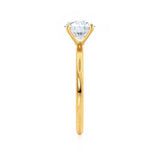When did engagement rings start? The tradition of giving an engagement ring dates back to ancient times, with varying customs across different cultures. From the Roman Empire’s iron rings to the glittering diamonds of modern-day proposals, the concept of engagement rings has evolved significantly. Today, engagement rings are not only a symbol of love and commitment but also a way for couples to express their unique identities, values, and cultural backgrounds. One of the most significant trends in contemporary jewelry design is the rise of multicultural engagement rings, which celebrate diversity and blend elements from different cultures to create something truly special and meaningful.
Creating a multicultural engagement ring involves merging symbols, materials, and designs from various traditions. The idea is to create a ring that speaks to both partners, reflecting their shared values while honoring their individual cultural heritages. For example, a couple may choose to incorporate gemstones that hold cultural significance in both of their backgrounds. In some cultures, emeralds are seen as symbols of fertility and rebirth, while others might favor sapphires for their associations with wisdom and loyalty. By selecting stones that have personal or cultural meanings, couples can create a piece of jewelry that feels deeply connected to their identities.
The band of the ring itself is another area where cultural influences can come into play. In some cultures, gold is considered a sacred and powerful metal, representing wealth and prosperity. In others, silver is more common, symbolizing purity and humility. For example, a couple might opt for a ring made of mixed metals, combining both gold and silver to reflect their diverse backgrounds. The shape and design of the band can also be influenced by cultural motifs, such as Celtic knots, African tribal patterns, or intricate Middle Eastern filigree work. These designs can be woven into the ring’s structure, making it a representation of the couple’s shared journey and intertwined lives.
Incorporating personal or cultural symbols into an engagement ring is also a beautiful way to celebrate diversity. These symbols might represent shared family traditions, religious beliefs, or even personal experiences that have shaped the couple’s relationship. For instance, a couple from different cultural backgrounds might choose to engrave symbols from both of their heritages, such as a Chinese character and a Native American symbol, to honor both sides of their family history. This practice can help create a deeper connection between the couple, as the ring becomes a reflection of the two worlds they come from.
Designers who specialize in multicultural engagement rings often draw inspiration from a variety of sources, ensuring that the final product is both meaningful and visually stunning. They may collaborate with clients to understand the significance behind certain colors, stones, or motifs, and translate these ideas into a unique and beautiful ring. Working with an experienced designer can help couples navigate the complexities of blending cultural elements while ensuring that the ring feels cohesive and timeless.
For some couples, the choice of gemstone is particularly significant. Diamonds, although popular worldwide, may not hold the same cultural value in every tradition. Couples may choose to incorporate alternative stones that are meaningful to their heritage. For example, an Indian bride may prefer a ruby, as it symbolizes passion and devotion in her culture, while a partner from a Scandinavian background might choose an opal, which is thought to bring luck and protection. By selecting a gemstone that holds significance for both individuals, the engagement ring becomes a tangible representation of their love and cultural unity.
A multicultural engagement ring is more than just a piece of jewelry; it is a powerful symbol of connection and respect for diversity. As the world becomes increasingly interconnected, the desire to celebrate different cultural traditions and values in personal celebrations like engagements grows. These rings are not only a way to commemorate the couple’s love but also a way to honor the unique paths that led them to one another. By incorporating meaningful symbols, materials, and designs from multiple cultures, a multicultural engagement ring serves as a timeless reminder of the couple’s shared journey and the beauty of their diverse backgrounds.
In conclusion, creating a multicultural engagement ring allows couples to celebrate the richness of their individual heritages while building a future together. Whether through the use of symbolic gemstones, mixed metals, or intricate cultural patterns, these rings reflect the values, traditions, and love that make each relationship unique. By choosing to celebrate diversity in their engagement ring, couples can create a piece of jewelry that tells a story of unity, respect, Hdhub4u and love across cultures.







